Anthurium in general and the Anthurium Scherzerianum specifically remain some of the most favored tropical plants and flowers purchased.
Other names for this anthurium are the flamingo flower plant or flamingo lily.
The flowers of the Anthurium Scherzerianum have a long, six-week vase life.
The leaves of this plant are highly ornamental as well.
In this article, I will discuss how I take care of my Anthurium Scherzerianum.
Anthurium Scherzerianum Care
For Anthurium Scherzerianum care use a well-draining potting mix using orchid bark, perlite, peat moss, and horticultural charcoal as well as some potting soil. The optimal temperature for an Anthurium Scherzerianum is 65 degrees to 90 degrees F to thrive (18 to 32 C). Provide bright indirect sunlight. An east-facing window is optimal. Humidity should be between 70-90% for ideal conditions but anything above 60% is considered good. Fertilize once every two weeks in spring and summer and once a month in autumn and winter.
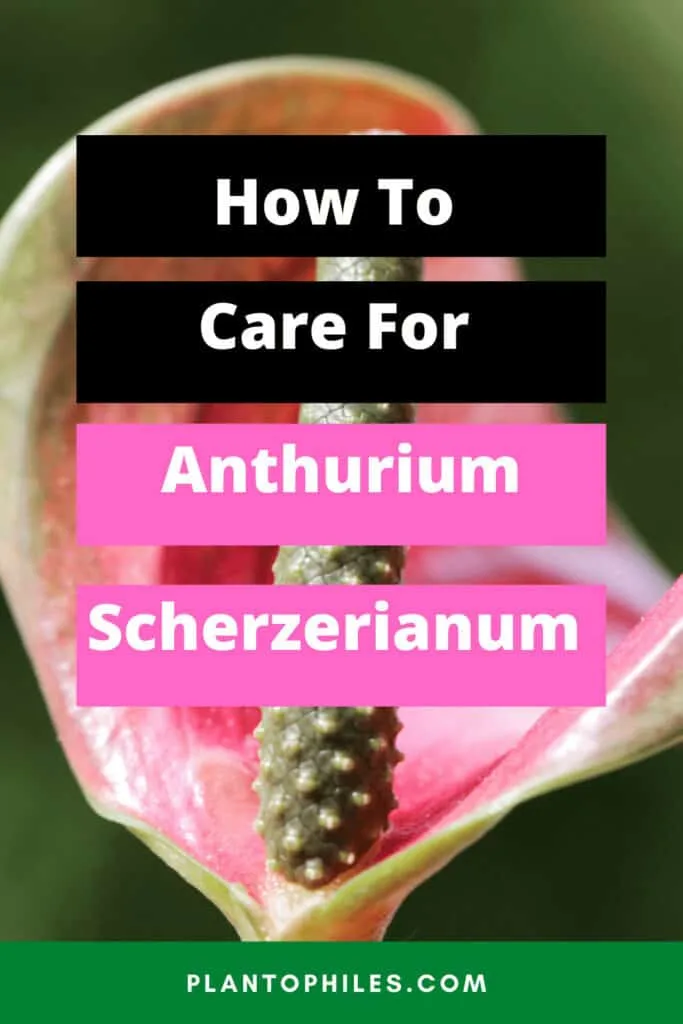
How to Care for Anthurium Scherzerianum
Table of Contents
How to care for Anthurium Scherzerianum
Soil
The most important aspect of Anthurium care by far. You will need airy, well-draining soil for your Anthurium Scherzerianum to thrive.
Aroids are plants that grow on other plants and objects meaning that roots are somewhat to not covered at all.
This allows for airflow to the roots in nature and so it needs to be in your home.
Use orchid bark, perlite, peat moss, and horticultural charcoal, and some potting soil to create a great soil mix for your Anthurium Scherzerianum.
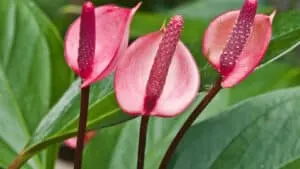
Anthurium Scherzerianum in bloom
Light
Provide bright indirect light for an Anthurium Scherzerianum indoors.
Outdoors the Anthurium Scherzerianum is best put in a location that is partially shaded.
The big mistake with lighting that I made as well is to look at care guides that mistake indoor care for outdoor care.
A partially shaded area outside is so much brighter than anything you most likely can provide in your home.
Therefore partial shade should never result in you putting your Anthurium in a somewhat shaded area in your home.
Plant at home like to be close to windows or you will need to support them with artificial grow lights.
For sure, a south-facing window might be too much where your Anthurium gets direct sunlight for many hours a day.
An optimal window placement can be an east-facing window.
In an east-facing window the Anthurium Scherzerianum has 3-4 hours of direct sunlight in the morning.
This is fine because the sunlight that plants receive in the morning is less strong.
In addition 3-4 hours max of direct sunlight is fine if the houseplant is not too close to the window and if it is used to it.
Watering
Let’s start with a general rule of thumb. Water your Anthurium Scherzerianum about once a week.
Apart from choosing the wrong soil, water is the task that can go wrong the most. If you overwater, your Anthurium Scherzerianum will develop root rot.
This is a condition where the roots are rotting.
Since this is highly contagious, healthy roots will get sick from unhealthy roots and it is spreading fast.
Within a couple of days, your Anthurium will wilt and die.
If you underwater, your plant will wilt and die as well.
So the solution is to provide just the right amount of water each time which can be tricky to figure out in the beginning.
What helped me the most is to conduct the finger test.
Put your index finger or any finger of your choice into the soil and check if the soil is still moist.
If that is the case, do not water. Only start watering when the soil is slightly moist.
I started by saying that you should water your Scherzianum about once a week.
The problem with this statement is that I do not know the conditions you are growing your plant in.
Important factors are first and foremost the soil, the humidity and temperature levels in your location and home as well as the sunlight the plant receives and the pot.
In general, the warmer it is and the more sunlight or artificial light your Anthurium Scherzerianum receives, the more you need to water.
So you might be watering every 2-3 days or even every day if you are living in a tropical place.
Water less in autumn and winter as this is when your Anthurium will grow the least and will need less energy and water.
In conclusion, it is always best to do the finger test, and once you have more experience work out a rhythm that works for your plant and stick to it.
One last thing. I often struggled with watering myself. What I found out after countless plants with root rot was that not the watering but the soil mix was the problem.
If you don’t use airy, well-draining potting soil you almost cannot water your houseplant the right way since the soil will become soggy and not drain for days.
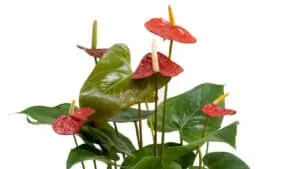
Multiple flowers on Anthurium Scherzerianum
Temperature
The optimal temperature for an Anthurium Scherzerianum is 65 degrees to 90 degrees F to thrive (18 to 32 C).
Keep the temperature above 60 degrees F (15 degrees C) as if you feel cold your plant will to and will certainly not thrive.
Humidity
The optimal humidity for an Anthurium Scherzerianum lies between 70-90%. Everything above 60% is already great.
I can tell you from my personal experience that high humidity is a game-changer.
Sure an Anthurium Scherzerianum will not die in low humidity of let’s say 40%.
There are a lot of people that pride themselves that they are able to grow Anthurium and other aroid plants in low humidity.
They are not wrong. But if you want to see air roots shooting out everywhere and plants growing like crazy strive for very high humidity.
An easy way to produce such an environment is to put your Anthurium Scherzerianum in a plastic container.
Seal it completely and open it up every day or at least every couple of days.
And the tell me what you see. I can guarantee you that your plant will grow vigorously.
Other ways to achieve high humidity are humidifiers, pebble trays (although this only increases humidity slightly) as well as putting plants close together.
I am not a big fan of spraying plants with water as this will do absolutely nothing for the humidity levels and there is always a chance for leaf rot if you do not have enough airflow and leaves remain too wet for too long.
Fertilizer
Fertilize your Anthurium Scherzerianum every two weeks in spring and summer and revert to once a month in Autumn and Winter. Use a diluted fertilizer at half strength.
The reason for this is simply that an Anthurium plant and any plant for that matter will grow more in spring and summer which are considered the main growing seasons.
In autumn and winter, you will come across less growth.
Depending on how much artificial light and warmth you can apply you can for sure counter this a little bit in your home and have your Anthurium Scherzerianum growing well all year long.
It is up to you if you want to choose slow-release or liquid fertilizer.
I prefer liquid fertilizer as this lets me measure exactly how much fertilizer my plants get.
A big advantage of slow-release fertilizer is that it is available to the plant all the time or as long as it isn’t absorbed fully.
If you can choose an organic fertilizer as the chances of root burn are much lower and an organic choice is a more natural and almost always the better choice.
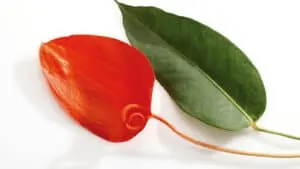
Leaf and flower in one picture. Look at the lanceolate leaf shape
Propagation of Anthurium Scherzerianum
3 common methods exist to propagate an Anthurium Scherzerianum.
You may raise them from seed, use the vegetative reproduction method by taking cuttings, and tissue culture.
Vegetative propagation, or cuttings, remains a popular way to propagate Anthurium Scherzerianum because it is a much quicker method than growing this Anthurium from seeds.
In addition, you do not net laboratory equipment and expert knowledge to propagate Anthurium Scherzerianum from cuttings.
How to propagate Anthurium Scherzerianum from Cuttings
Step One
Use pruning shears to cut off a stem that is at least six inches in length. Make sure the stem has at least two or three leaves and a node.
Without a node, there is zero chance for a new plant to grow from the cutting.
Step Two
Find a 10-inch pot.
Fill the plant’s container with approximately three-fourths full of potting soil that remains well-drained when water is added. Please be sure there are drainage holes in the bottom of the pot.
An alternative way is to use water or sphagnum moss.
My personal preferred way to propagate cutting is to first put them in water for 3-4 weeks.
Once I see roots and transfer the cutting in slightly moist sphagnum moss in a sealed container.
This by far gives me the best results in terms of root growth and speed of turning a cutting into a new plant.
Step Three
If we assume you are continuing with putting the cutting directly into the soil.
Make a two to three-inch-deep hole in the center of the soil in the pot either using your finger or a hand spade.
By the way. Putting a cutting directly into the soil might be an even faster and more natural method.
The big advantage here from my experience is that you do not have to transfer the cutting from one medium to the other.
Because the transfer from one potting medium is a shock to any plant.
The main disadvantage of going straight for soil is that you cannot see the roots growing and you do not know for sure for several weeks if your cutting is doing fine.
For this reason, I almost always use sphagnum moss or water or a combination of both.
Anyways, let’s continue with the soil propagation of an Anthurium Scherzerianum.
Step Four
Place the cut part of the Anthurium in the hole, then fill the void with more potting soil.
Don’t let the lower leaves of the cutting get into the hole. Pull these leaves off with your fingers if necessary.
Step Five
Water the soil until all of the dirt becomes saturated. Water the plant about every other day, and don’t let the top layer dry out.
Anthuriums like moist conditions, but don’t overwater these plants or let them stay in wet conditions.
Step Six
Plant your newly propagated plant in a place with humidity and plenty of filtered light. Natural light is preferred. It will take about six weeks for new roots to develop.
You’ll know your plant has roots when you begin to see your new plant sprouting additional foliage or getting taller.
Anthurium Scherzerianum Growth
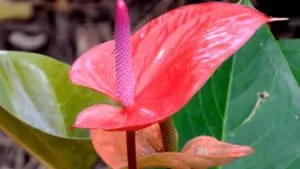
Anthurium Scherzerianum spathe and spadix aka bloom or flower
This plant grows 12 to 18 inches tall (30-45cm). The spadix is orange-red.
The leaves or foliage is very shiny and shaped like a lance or lanceolate. They are around 8 inches (20cm) long.
Anthurium Scherzerianum grows put to 2 inches (5cm) in the growing season. It is considered a moderate grower.
I can say from personal experience that it is a rather good grower and will produce leaves at least monthly at a consistent rate in my care.
Potting
Do not pot the Anthurium Scherzerianum deeper than 5 inches as a rule of thumb. The danger of stem rot is real.
Choose a pot that has drainage holes at least at the bottom.
More and more I am using pots with drainage holes on the sides as well as airflow to the roots is so important.
If you once had root rot you never want to go back.
Therefore I do everything that allows for great drainage and airflow such as choosing a chunky potting mix, and drainage holes everywhere.
When talking about potting and repotting Anthurium Scherzerianum shouldn’t have to be repotted more than every 2-3 years depending on how fast it is growing.
Once the plant becomes root or pot bound you will see it when its growth starts to slow down or stop entirely.
A different sign might be yellow or much smaller foliage.
But in the best case, you realize it before that.
I use both plastic and terracotta pots.
What you need to know is that plastic pots retain moisture longer which can result in less watering.
Terracotta pots are porous and can absorb water and allow for air exchange.
I like terracotta pots as they might protect you from overwatering.
On the other hand, a plastic pot with drainage holes is fine as well.
Tip: Do not choose a pot that is too big. The temptation is there I can understand. But just don’t do it. It is the same as with watering. You don’t care better for your plants if you water more, you kill them. Same for pot size. Only go up one to two sizes max each time. A small plant needs a small pot, basta.
Why my ramblings about pot size? The problem with pots that are too big is that you cannot control the watering.
You water a lot but your Anthurium Scherzerianum will not reach the water if the roots are too short.
So it will dry out.
Or the more likely problem will be that there is too much water in the pot after the watering because your plant is small and has small roots and it will take multiple days or weeks for the soil to dry out again.
Either of these or a combination may mean the end of your botanical friend.
Toxicity
Anthurium Scherzerianum is toxic to pets according to ASPCA. They contain calcium oxalate crystals not uncommon in the aroid family of plants. This can lead to oral irritation as the chrystals penetrate skin tissue. The mouth and tongue can swell. Drooling and vomiting can occur. It becomes difficult to swallow.
As Anthurium Scherzerianum is toxic to cats and dogs can a vet if you see that your pet ingested any part of the plant.
Anthurium Scherzerianum Detailed Care Guide
Description of Anthurium Scherzerianum
The flower of the Anthurium Scherzerianum is heart-shaped, waxy, and cheerful orange color, though other colors of anthurium flowers exist.
This striking-looking plant has colorful red, pink, or orange spathes with shiny lance-shaped medium green leaves. The leaves grow to be about eight inches long.
The Anthurium Scherzerianum usually blooms from spring through the summer. Keeping the plant’s leaves clean and misted adds to its beauty.
The stem of the plant can grow to a height of 12 to 28 inches tall, depending on the size of the spathe.
Plants with bigger spathes require longer stems.
Anthurium Scherzerianum’s large leaves are an attractive medium green color and are borne on tall, slender stalks. The flowers end in a column containing many unisex flowers.
The plant’s flowers are a lovely medium red, bright pink, or orange flowers with an orange spathe.
When you cut Anthurium Scherzerianum flowers and leaves, they can last for up to six weeks. Because of the longevity of the flowering bracts, the cut flower loves using the anthurium as both a potted plant and in flower arrangements.
The anthurium plant is toxic, both in its leaves, stems, and sap. This plant should be enjoyed for its beauty but kept away from small children and animals.
People and pets may get mild stomach problems when the plant becomes ingested. Skin irritation may also occur when touching the sap, so be sure to wear gloves when touching the juice of the plant.
How to Grow Anthurium Scherzerianum Indoors
Anthuriums are quite remarkable in that they can be grown in a wide variety of types of soil such as sandy loams to heavy clay dirt. Some of the other requirements for growing anthuriums like Anthurium Scherzerianum include:
- Anthurium Scherzerianum prefers an organic soil that retains water but drains quickly.
- The container or soil must drain easily, or stem and root rot may occur.
- Don’t plant anthuriums any deeper than 5 cm deep. Planting this plant any deeper can cause stem and root rot.
- Once you’ve planted the plant, stake it for support.
- Water the anthurium well after you’ve planted it.
- Mulch the plant with coconut husks or semi-rotted wood to keep in moisture.
- The roots of Anthurium Scherzerianum grow and spread in the mulch, not just into the dirt. This fact is essential to understand before you transplant Anthurium Scherzerianum so that you can keep the roots together.
How to Grow Anthurium Scherzerianum Outdoors
A stunning addition to any landscape design remains a bed of glistening red Anthurium Scherzerianum plants. Because anthuriums are native to South and Central America, they can be grown outdoors if you live in a tropical climate. Adding a few anthuriums to your outdoor garden gives the area an exotic and tropical feel.
Growing Anthurium Scherzerianum indoors remains easy, but growing them outdoors is a bit trickier. To produce your Anthurium Scherzerianum outdoors, you’ll need to live in an area that doesn’t get below 60 degrees F, because this showy plant wants temperatures of 60 degrees to 90 degrees F to thrive (15 to 32 C.). Keep the temperature above 64 degrees F (18 degrees C) for ideal conditions.
You can plant your anthuriums in a movable pot and bring them indoors when the weather becomes colder if you live in a less tropical climate.
Be sure to plant your Anthurium Scherzerianum in well-drained soil, and water them only when they are dry. Mulching outdoor anthuriums help them retain their moisture and prevents the signs of overwatering like root rot.
These plants, when planted outdoors, prefer partial shade or indirect light that is filtered by other plants. They also don’t like being placed where they’ll get lots of exposure to the wind. An Anthurium Scherzerianum planted outdoors need to be fertilized about once every two months and should be kept away from places where pets and children spend time.
How Do You Care for Your Anthurium Scherzerianum?
Plant care for any anthurium plant remains relatively straightforward. Some of the ways to care for your Anthurium Scherzerianum plant include:
- Removing dead or unsightly leaves and faded flowers from the plant.
- Use peat moss and perlite based soil for your plant.
- Provide your anthurium with a high level of light, but don’t leave them in direct sunlight.
- When you water your Anthurium Scherzerianum, water it thoroughly. Also, allow the plant’s soil to dry out completely before watering it again. You’ll need to water the plant about once per week.
- Overwatering the plant will cause the roots to rot and leaves to yellow.
- An Anthurium Scherzerianum doesn’t need lots of fertilizer. They should be fertilized according to the fertilizer’s instructions about once every two months.
- Place your plant in a place in the house or outside that doesn’t experience wide fluctuations in temperature.
- All anthuriums need a winter rest with temperatures of about 60 degrees F. and very little water. If you give your plant a winter rest, the result will be lots of flowers the following season.
Four Common Mistakes People Make when Growing Anthurium Scherzerianum Plants
1. Overwatering
Overwatering remains the leading cause of death for anthuriums. Please be sure to water your plant only when the soil is thoroughly dry to prevent root rot and plant death. This plant growing rule means you’ll provide about six ice cubes worth of water for your plant about once per week.
Also, be sure your pot drains off the excess water, so it doesn’t stagnate around the anthurium’s roots.
2. Lack of water
If you stick to a once-per-week watering schedule, your anthurium shouldn’t get completely dried out. If something happens and you forget to water your plant for a while, take the plant out of the container and soak the root’s ball in lukewarm water to rehydrate the plant.
3. Anthurium Scherzerianum Pests
Pests seem to harm anthuriums grown outdoors more than they do indoor plants. Because anthuriums have thick leaves, chewing bugs don’t like to eat them. Sucking pests, however, feed on the plant’s sap.
To avoid an infestation, keep a close watch on your plants, and wipe down the shiny leaves from time to time with a pyrethrin-based insecticidal treatment. Insecticidal soap also treats infestations of bugs on anthuriums.
4. Brown or Burnt Leaves
If the leaves of your plant become brown, yellow, or look burned, your plant receiving too much direct sunlight. Remove your plant’s brown leaves and move it to an area where the light is indirect as soon as you can.
Humidity and Temperature
An Anthurium Scherzerianum prefers temperatures higher than 55 degrees F and 90 degrees F. They also like areas with 80 percent humidity. These two requirements alone make the plant an excellent choice for bathroom décor. You can add a humidifier and add a heater to the area around the anthurium to keep it at the right humidity and temperature levels to be happy and healthy.
Anthurium Scherzerianum with Stunted Growth
Repotting all anthuriums remains crucial to their health and growth. The Anthurium Scherzerianum plant should be repotted every two to three years.
If you have roots growing through the drainage holes, or at the top of your potting mixture, it’s time to re-pot that plant. Choose a well-drained soil and the next size up of pot and move your plant, so it has room to grow.
With all of these tips, you, you’re family and friends can enjoy the exotic tropical beauty of Anthurium Scherzerianum in your own home.
Frequently Asked Questions About Anthurium Scherzerianum
Are anthurium plants poisonous?
Anthurium plants are indeed toxic. Unfortunately, all parts of this beautiful plant contain insoluble calcium oxalate. When eaten or also when just chewed, this can result in intense pain and irritation. If lips or tongue become swollen, immediately seek urgent medical attention.

Daniel has been a plant enthusiast for over 20 years. He owns hundreds of houseplants and prepares for the chili growing seasons yearly with great anticipation. His favorite plants are plant species in the Araceae family, such as Monstera, Philodendron, and Anthurium. He also loves gardening and is growing hot peppers, tomatoes, and many more vegetables.


